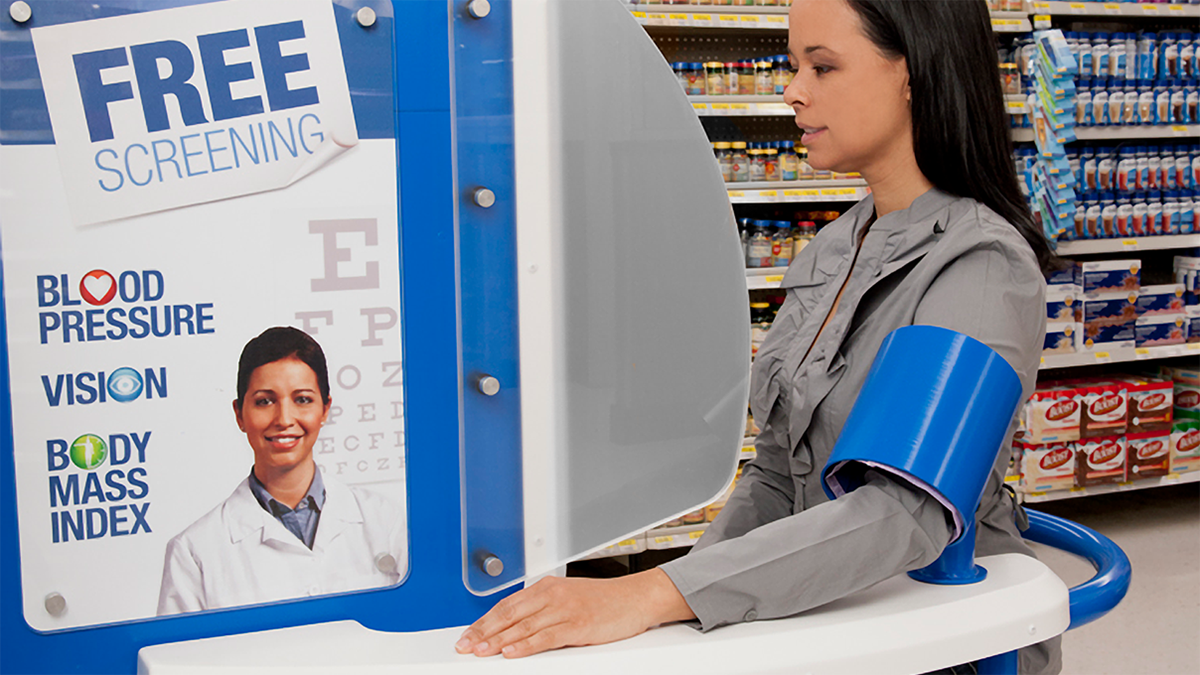In-store opportunities for patients to check in with their health may offer touchpoints to those who don’t regularly seek care.
Rates of self-reported hypertension and elevated blood pressure readings among adults using health kiosks in US retail stores tend to be higher than those obtained in nationally representative surveys, according to a look at more than 1 million people who tried such services.
Researchers say these easy-to-access tools may prove to be useful in examining patterns in blood pressure on a broad scale across the United States.
Roughly half of people using these kiosks in Walmart and CVS stores had high BP, defined as a self-reported hypertension diagnosis, a systolic reading ≥ 140 mm Hg, or a diastolic reading ≥ 90 mm Hg, lead author Thomas Hsiao, PhD (Emory University, Atlanta, GA), and colleagues report.
That included 33.6% who said they had received a diagnosis and 18.4% who had a high systolic and/or diastolic reading at the kiosk. For comparison, those rates were 30.5% and 10.3%, respectively, in the 2021-2023 cycle of the National Health and Nutrition Examination Survey (NHANES).
Despite the difference, however, the information obtained through self-service kiosks can be complementary to national health surveys like NHANES and the Behavioral Risk Factor Surveillance System (BRFSS), which have seen declining participation rates in recent years, co-author Jithin Sam Varghese, PhD (Emory University), told TCTMD, noting that response rates are particularly low among underserved groups with the heaviest burdens of cardiovascular disease and diabetes.
These kiosks are free to use, “presenting opportunities to reach underserved populations,” Varghese added. “Low-income and rural Americans disproportionately shop at Walmart, so it’s possible for us to find out how they’re doing in terms of their high blood pressure.”
The results were published online August 6, 2025, as a brief report in JAMA Cardiology.
‘Untapped Opportunities’
For the current study, the investigators examined BP information obtained from Pursuant Health’s self-service kiosks found in US Walmart and CVS stores between November 2017 and September 2024. The data represent 1,892 counties across 49 states (except for Massachusetts) and the District of Columbia.
Of the roughly 1.27 million adults (mean age 42 years; 52% men) measured at kiosks, 17% lived in rural areas. The largest self-reported racial/ethnic group was white (42%), followed by Hispanic (27%), Black (18%), Asian (7%), and other (6%).
During the study period, the prevalence of high BP based on either self-reported diagnosis or elevated readings was 47.4% based on kiosk data—it was 50.0% in 2017-2018 and 47.6% in 2023-2024. Non-Hispanic Black individuals had the highest rate of elevated BP during each 2-year interval. Men, individuals older than 65 years, and those living in rural areas all tended to have increased rates.
High BP was more common in this study compared with the rates reported in NHANES, which were 40.7% in 2017-2020 and 36.8% in 2021-2023. The authors note, however, that the protocol for measuring BP was less rigorous at the kiosks than within that national survey.
In an accompanying editor’s note, Sadiya Khan, MD (Northwestern University Feinberg School of Medicine, Chicago, IL), an associate editor of JAMA Cardiology, and colleagues point to some limitations of the analysis, including the potential for measurement error and sampling bias, with an increased chance that people who were aware that they had high BP being more likely to use the kiosks.
“However, retail store BP kiosks represent a promising and underused tool to improve hypertension awareness, monitoring, and management on a national scale,” and one that “may be integrated into care delivery pathways to improve hypertension care,” they write.
The kiosks may also be useful for speeding and diversifying recruitment into clinical trials to test scalable interventions and “may provide an innovative platform for population surveillance studies,” Khan et al say.
“Although there are many untapped opportunities,” they conclude, “broader use of kiosks will require investment in population health, including in creation of infrastructure to ensure protection of data privacy and safety monitoring for clinical trials and care delivery.”
With self-service kiosks widely available in places where most Americans shop, “there’s no real barrier to accessing blood-pressure screening,” Varghese said. “So if somebody is at a Walmart, they can go get themselves screened for free and it’s in a convenient location. Anytime somebody goes there to shop, I would just recommend getting their blood pressure measured.”
Moreover, Varghese added, kiosks provide an opportunity to connect people without access to care with “some kind of personal health monitoring,” as this population tends to be excluded from national health surveys. “There are a lot of potential opportunities in terms of linking kiosks with somebody’s primary care records provided we can develop some kind of a secure data transfer protocol,” he concluded.
